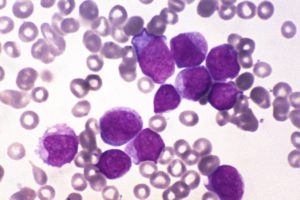Acute myeloid leukaemia prognostic and diagnostic screening

Acute Myeloid Leukaemia (AML) is a type of aggressive blood cancer, with several molecular sub-types. Current treatments aim to reduce (to less than 5% of the original amount) levels of leukemic stem cells (LSC), which are thought to be responsible for sustaining the disease and leading to relapse. However, until now, no technologies were available that could determine the molecular sub-type of AML present in the patient (to predict disease course and inform treatment with targeted therapeutics) and detect and monitor the levels of these remaining LSCs.
Driven by this unmet need, researchers at the University of Oxford have discovered combinations of cell-surface biomarkers which are capable of meeting both objectives. This combination is currently under development to be used as a diagnostic and prognostic screening tool to fight against AML relapse and to improve the management of the disease.
Acute Myeloid Leukaemia (AML) is a type of aggressive blood cancer, with several molecular sub-types. Current treatments aim to reduce (to less than 5% of the original amount) levels of leukemic stem cells (LSC), which are thought to be responsible for sustaining the disease and leading to relapse.
However, until now, no technologies were available that could determine the molecular sub-type of AML present in the patient (to predict disease course and inform treatment with targeted therapeutics) and detect and monitor the levels of these remaining LSCs.
Driven by this unmet need, researchers at the University of Oxford have discovered combinations of cell-surface biomarkers which are capable of meeting both objectives.
Advantages of the biomarkers
- Improved sensitivity in AML diagnosis and prognosis
- Patient stratification, saving time and money by avoiding inappropriate treatments and improving patient wellbeing
- Assessment of treatment efficacy
Current challenges in AML therapy
The goal of AML therapy is to reduce the amount of bone marrow leukaemic cells to less than 5%. However, despite this level of reduction, most patients relapse without post-induction chemotherapy or a haematopoietic stem cell transplant. These procedures aim to eliminate minimal residual disease: leukaemic cells that resist therapy. Leukaemic stem cells (LSC) are thought to be responsible for sustaining disease.
The advantage of the Oxford biomarkers is that they follow LSC populations directly and hence provide a novel strategy for following disease progression.
The new biomarkers detect LSC at lower levels than was previously possible.
Recent studies have also demonstrated that AML consists of a group of diseases, and this technology allows stratification of patients by disease sub-type, allowing the most appropriate treatment to be selected, potentially improving treatment efficacy.
AML facts
- An aggressive cancer of the myeloid line of white blood cells
- The most common adult acute leukaemia, affecting over 15,300 people a year in the US and UK combined
- More common in adults aged over 65, with only 5% overall survival in this patient group
- Prevalence is expected to increase as the population ages
Supporting data
Clinical and in vivo proof-of-concept data showing that the biomarker combinations identify LSCs:
Goardon N et al (2011). Cancer Cell. 19(1):138-52
Quek L et al (2016). J Exp Med. Jul 25;213(8):1513-35
Kinstrie et al (2016). Blood Advances. Vol 1 (3): 160-169
Patent position
This technology is subject to a family of international patent applications including use and method claims for biomarkers for AML. Oxford University Innovation would like to hear from companies who wish to license this technology for further development.
about this technology

